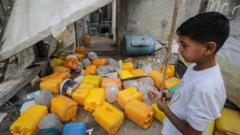On May 18, 2025, Pope Leo XIV, the inaugural American pope, officiated a momentous Mass attended by global dignitaries and worshippers, underscoring themes of peace, community, and modern challenges like AI and war.
Pope Leo XIV's Inaugural Mass: A Historic Beginning for the First American Pope

Pope Leo XIV's Inaugural Mass: A Historic Beginning for the First American Pope
World leaders gather in Vatican City to witness the opening of Pope Leo XIV's papacy, marking a significant moment for the Roman Catholic Church.
Current time in Vatican City: 10:04 a.m. May 18
Updated: May 18, 2025, 4:03 a.m. ET
Pope Leo XIV presided over his inaugural Mass on the morning of May 18 in St. Peter’s Square, surrounded by a crowd that included influential world leaders and church officials, officially marking the beginning of his tenure as the first American pontiff. Among the attendees were Vice President JD Vance, Secretary of State Marco Rubio, Ukrainian President Volodymyr Zelensky, Canadian Prime Minister Mark Carney, and Australian Prime Minister Anthony Albanese.
Elected as the 267th pope earlier this month, Pope Leo, born Robert Francis Prevost in Chicago, embodies a shift in papal tradition, challenging the notion that cardinals would overlook a leader from a global superpower with significant political sway.
As the Mass commenced, Pope Leo expressed early priorities for his papacy, notably the dangers posed by artificial intelligence and his advocacy for peace, particularly in regions like Ukraine and Gaza. The pontiff expressed an intention to elevate the experiences of "ordinary people" during these turbulent times.
From the start of the ceremony, more than 6,000 visitors streamed into St. Peter’s Square, having traveled from all corners to witness the historic event. The Pope, an Augustinian friar, is expected to incorporate values from his religious order, placing importance on dialogue and missionary outreach while seeking unity within the church, particularly among American Catholics—a community currently facing complex questions around identity and influence.
Vice President Vance’s presence is viewed as a potential thawing of relations between conservative Americans and the Vatican, especially since Church dynamics have seen increased friction amid differing theological positions. The historical context surrounding Vance's attendance alongside Leo highlights a pivotal moment for the Catholic Church, connecting both politics and faith, represented through symbols and messages of unity during the Mass.
Ceremonial aspects included the passing of the fisherman’s ring and the pallium to symbolize Pope Leo's responsibilities, coupled with the communal acknowledgment of his guidance over the 1.4 billion Catholics worldwide. The Pope's initial engagements resonated widely, showcasing a vision that blends traditional values with contemporary challenges—a signpost for his administration's outlook in the coming years.
As Pope Leo embraced this new chapter in his ministry, a chorus of enthusiastic chants and waves greeted him, reflecting the hopes of many attending and the global community watching as he begins his service amid calls for compassion and action in the modern age.




















